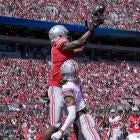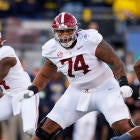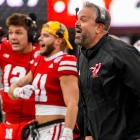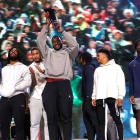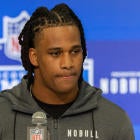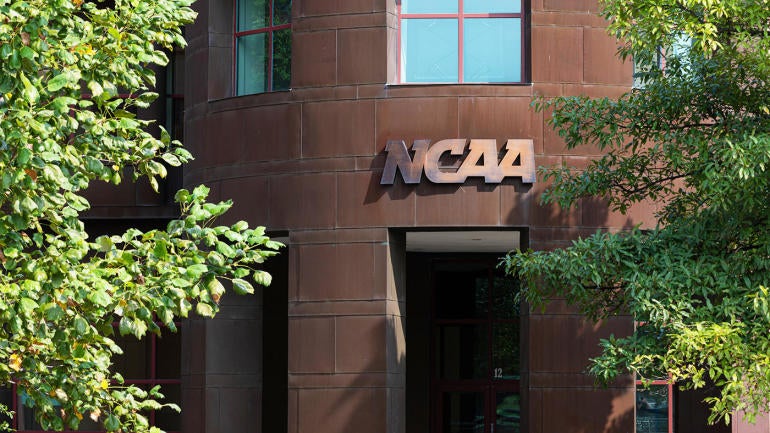
One Power Five athletic director recently winced after taking a glimpse at his balance sheet. His financial outlook is not much different than his peers' with multiple high-speed bullet trains all coming into the station at the same time. The most unpredictable of all being expected revenue sharing with athletes through collective bargaining.
"It feels like my budget is about to look like a murder scene," that AD said.
Those projections -- typically called pro forma budgets -- are based on "what if?" hypotheticals. Like any good business person, an AD attempts to determine what expenditures are ahead and how much revenue will be coming in. Right now, they are struggling to project either.
Put up the yellow crime scene tape and pull up a chair because "what if?" is getting complicated. The NCAA and the Power Five conferences find themselves as defendants in four high-profile antitrust lawsuits. Settlements in those cases have become the next hurdle toward whatever college sports will look like in the future.
NCAA president Charlie Baker is being urged by a sizable portion of the membership to settle the cases because the alternative is too chilling to consider.
"You may bankrupt some universities," another Power Five AD said.
The biggest, most concerning obstacle is the House v. NCAA suit that goes to trial in 10 months. Given that timetable, this may be the last March Madness played under the old rules, if not the current membership.
The hope? Somehow, all the four cases are bundled and settled at once. For the moment, they pose the biggest immediate financial threat to the existing system. In antitrust cases, damages are trebled. That suggests the NCAA and Power Five probably cannot risk jury trials in any of the cases. In House alone, trebled damages would be a reported $4.2 billion, which could conceivably bankrupt the NCAA as well.
Even if settled, the cases may cost eight figures per school. The NCAA would no doubt cover some of the settlement, but since the Power Five conferences are also defendants, schools are almost certainly going to shoulder some of the burden.
And if they can't?
"If there is a settlement in that [House] case," said a third Power Five AD. "That's going to define the new subdivision."
There are 68 schools in what will become the Power Four starting July 1, 2024. Will all 68 be able to afford what those bullet trains are delivering: basically an employment model?
"A settlement for House and all the others, it could almost be like what a collective bargaining agreement would sort of look like," said Mit Winter, a Kansas City-based sports law attorney. "In terms of, 'Here's what the rules are going to be going forward, NCAA. You're going to share it with the athletes.'"
The settlements would most likely be optional for schools that want to contribute -- "permissive" is the industry buzz word. Will there be some that don't (or financially can't), risking their membership at the highest level of college athletics?
In December, Baker proposed a new subdivision as well as a trust fund for players. The latter piece would also be permissive. (There has been reported pushback on a new subdivision from NCAA members.)
In this case, the knife that cleaves the FBS into further subdivisions would occur more organically. Schools would have to answer one basic question when the settlement money comes due: What can we afford?
Before answering, layer in the looming factors of unionization and forthcoming revenue sharing.
In each case, the money required for programs to remain at a power-conference level will need to come from somewhere: reserves, reallocation of existing funds, state subsidies, borrowing from the university, bank loans.
"Universities, because they're big enterprises, actually have access to really cheap debt," said Tony Altimore, a strategy consultant with Altimore Collins & Company. "Universities are zero risk [for lenders]. The University of Michigan isn't going anywhere."
Outstanding legal cases
- House v. NCAA: The most urgent and significant in regard to the existing collegiate model. It seeks backpay for athletes in NIL benefits as well as shares of broadcast and video game revenue. The case goes to trial in January 2025.
- Fontenot v. NCAA: It alleges, based on broadcast rights alone, that colleges can certainly afford to pay players. Example: Texas A&M had enough money to pay Jimbo Fisher's $76 million buyout.
- Hubbard v. NCAA: This seeks backpay for the Alston verdict. That landmark 2021 decision saw the Supreme Court vote 9-0 to allow limited educational benefits that the NCAA had fought.
- Carter vs. NCAA: Like Hubbard, it argues that athletes should be paid more than the NCAA basics -- room, board, tuition, books and cost of attendance. This case was filed in December 2023and could take years to litigate.
Some of sort of bundling of settlements cannot come fast enough for those who don't want to rely on "what if?" to balance their budget.
These are tenuous times in the industry. Planning future budgets is also intertwined with current College Football Playoff media rights negotiations, the NCAA's NIL efforts in Congress and a private equity market that may -- some day soon -- own the whole thing.
"I can't imagine choosing to step into this right now," said Houston AD Chris Pezman. "It's a thankless job for a lot of people."
Some discussions have centered around schools opting into the settlement at a capped rate, perhaps 20% of a program's total athletic budget, sources tell CBS Sports. At top revenue producers like Texas and Ohio State, that could mean $30 million to $40 million per school.
Only a few handfuls of FBS programs even turn a profit. Those settlement numbers alone could be the first informal separating of the haves from the have-nots.
So, who wants to be in the exclusive club that emerges from the courts?
The Big Ten and SEC have already separated themselves -- financially, if not formally. The pair, which already generate the most revenue from their respective media rights deals, formed an "advisory group" last month, notably without the ACC and Big 12 and ACC.
Current negotiations reflect the combined swagger of the Big Ten and SEC, which are seeking a combined 58% of annual CFP revenue as part of a new media rights deal beginning 2026, sources confirmed to CBS Sports. That would equal approximately $754 million combined for two conferences -- an additional $22 million per school for those 34 institutions.
With the Big Ten soon to eclipse $75 million per school in media rights revenue alone, league programs could soon be raking in $100 million each annually.
Currently, there is $600 million being split annually among the 10 FBS conferences and Notre Dame. Sure, Ohio State, Michigan and Texas could afford massive settlements, but what about the likes of Wake Forest, Rutgers and Arizona, the latter of which currently faces a reported $177 million budget shortfall?
"There's never been more uncertainty about how universities need to budget their expenditures in the next decade," said Patrick Rishe, director of the sports business program at Washington University in St. Louis. "That being said, it's hard for me to feel empathy for the top 50, 60 financially endowed universities because look at what they're spending on facilities, look at what they're spending on coach salaries."
If the Big Ten/SEC are demanding a majority of the revenue, shouldn't they take on a larger share of the legal liability? There has already been speculation about the two conferences eventually becoming a "super league" with a promotion-relegation system similar to a proposed European soccer model.
"Are you going to split 60% of the revenue?" one Power Five AD asked rhetorically. "Then you have to pay [a majority of] the damages."
Meanwhile, there is the specter of private equity firms swooping in to buy low and sell high on what college athletics has become -- an undervalued stock. Despite record revenues, instability and lack of leadership in the space means college football might be worth 10 times more than it is now, according to Gerry Cardinale, founder and manager partner of Redbird Capital Partners.
Florida State is already way down the road with Project Osceola, conceivably a vast partnership with private equity.
Kansas is spending $450 million to write what is essentially a love letter to major college football in the next round of realignment. A massive facilities upgrade includes a complete remodel of the football stadium that was built -- in part -- by a young John Wooden working his way through school during a summer when he was a student at Purdue.
The unstated intent for both echoes a common theme: The desire to stay in the big time when the next round of realignment comes calling.
Meanwhile, those trains haven't slowed down. There is no room for them all to arrive at the same time. In Alston v. NCAA, the Supreme Court said as much, summarizing that the case "[falls] at the intersection of higher education, sports, and money."














